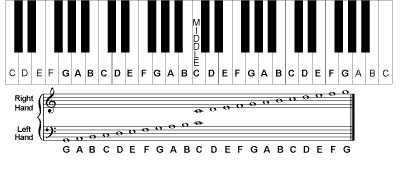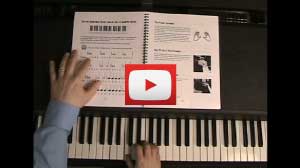More About the Piano Staff
The piano staff, also known as the "grandstaff," is actually two staves connected. The top staff, known as the "G" clef of "treble" clef, shows the music that the right hand will play. The bottom staff, known as the "F" clef or "bass" clef shows the music that the left hand will play.

Each staff is a set of 5 lines and 4 spaces. This set of lines and spaces covers notes that span just over one octave. The piano or keyboard with 88 keys has a range of more than 7 octaves. To show the notes that lie beyond the staff, lines are added as needed. These lines are called ledger lines. Notice middle C on the piano staff chart above. It is represented in both staves with a ledger line, one line below the staff for the G clef, and one line above the staff for the F clef.
How To Memorize The Note Names

The right hand line notes are E, G, B, D, F from the bottom up. Memorize the phrase above, or make up one that fits you personally. It helps to play the notes on the keyboard as you say them. Try this going up and down, and randomly.

The right hand space notes are F, A, C, E from the bottom up. This one is easy to remember: “FACE” rhymes with “SPACE.” The space immediately above the treble clef staff is G, and the space immediately below the staff is D.

The left hand line notes are G, B, D, F, A from the bottom up. The line immediately below the left hand staff is E, and immediately above is middle C.

The left hand space notes are A, C, E, G. The space immediately below the staff is F, and the space immediately above is B.
Start Playing Piano Today with the Piano Guide Quick Start Course!
Easy to follow step-by-step lessons designed for adult beginners. The next best thing to private lessons!
What You'll Learn:
- Notes on the piano/keyboard
- Proper fingering
- C major scale
- Chords
- How to read music
- And much more, for less than a buck!

Video lessons - watch as I play everything for you.

